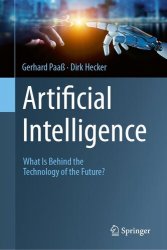Artificial Intelligence: What Is Behind the Technology of the Future?
- Добавил: literator
- Дата: 16-05-2024, 11:33
- Комментариев: 0
 Название: Artificial Intelligence: What Is Behind the Technology of the Future?
Название: Artificial Intelligence: What Is Behind the Technology of the Future?Автор: Gerhard Paaß, Dirk Hecker
Издательство: Springer
Год: 2024
Страниц: 485
Язык: английский
Формат: pdf (true)
Размер: 33.9 MB
Artificial Intelligence (AI) is already present in our daily routines, and in the future, we will encounter it in almost every aspect of life – from analyzing X-rays for medical diagnosis, driving autonomous cars, maintaining complex machinery, to drafting essays on environmental problems and drawing imaginative pictures. The potentials of AI are enormous, while at the same time many myths, uncertainties and challenges circulate that need to be tackled. This book is addressed to the general public, from interested citizens to corporate executives who want to develop a better and deeper understanding of AI technologies and assess their consequences. Mathematical basics, terminology, and methods are explained in understandable language. Adaptations to different media such as images, text, and speech and the corresponding generative models are introduced. A concluding discussion of opportunities and challenges helps readers evaluate new developments, demystify them, and assess their relevance for the future.
The purpose of this book is to clearly demonstrate the new possibilities of Machine Learning in different application areas, such as autonomous driving, medical diagnosis or the analysis of the meaning of language. The technical vocabulary but also concepts, methods and network architectures are explained with many graphics and pictures. Mathematical relationships are formulated when helpful, and always explained in a comprehensible way. It turns out that the methods used are composed of very simple operations, such as addition and multiplication. These gain their performance by being applied to very large sets of numbers and several times in succession. If one would like to understand the technical Chaps. 3, 4, 5, 6, 7, 8, and 9 in detail, a mathematical understanding at senior high school level is sufficient.
In recent years, advances in computer processing power and the availability of suitable programming environments and algorithms have made it possible to solve some Artificial Intelligence subtasks in a satisfactory manner. This chapter provides an informal overview of the state of the art. Of particular importance here is the interpretation of sensor data, such as recognizing objects in photos, diagnosing diseases from images, or transcribing spoken language into text. There has also been progress in analyzing the meaning of language, e.g., machine translation from one language to another, answering questions by an AI system, or conducting meaningful dialogues by intelligent assistants. Finally, AI systems have been able to beat human experts at computer games, automatically drive vehicles in real-world traffic, or perform creative acts, such as inventing new stories. The techniques used will be explained in later chapters.
Скачать Artificial Intelligence: What Is Behind the Technology of the Future?
Внимание
Уважаемый посетитель, Вы зашли на сайт как незарегистрированный пользователь.
Мы рекомендуем Вам зарегистрироваться либо войти на сайт под своим именем.
Уважаемый посетитель, Вы зашли на сайт как незарегистрированный пользователь.
Мы рекомендуем Вам зарегистрироваться либо войти на сайт под своим именем.
Информация
Посетители, находящиеся в группе Гости, не могут оставлять комментарии к данной публикации.
Посетители, находящиеся в группе Гости, не могут оставлять комментарии к данной публикации.
